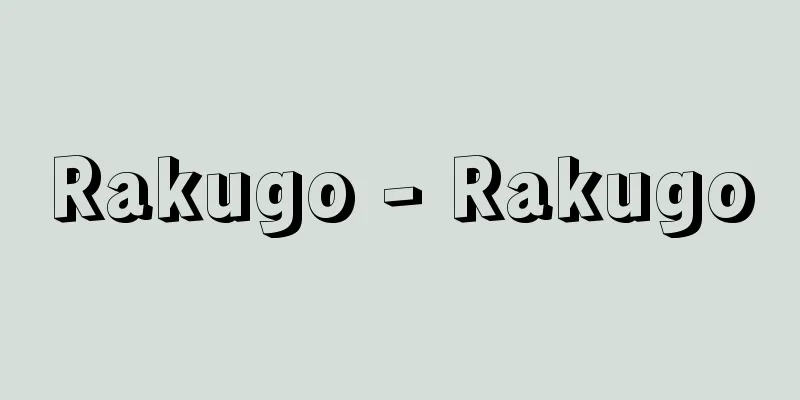Rakugo - Rakugo

|
This is a typical form of Japanese storytelling, and the name derives from the addition of a punch line (sage) to the end of a story. The storyteller sits alone on the stage wearing traditional Japanese clothing, and entertains the audience with humorous expressions and deeply moving performances using a folding fan and hand towel. The 1687 (4th year of the Jōkyō) edition of the Shojiki Banashi Okagami states that "In a story, the first step is the punch line, the second is the eloquence, and the third is the form," showing the basics of rakugo. Later, the format and performance of this pure storytelling art changed, and dramatizations such as theatrical tales, musical tales, ghost stories, human interest tales, and three-topic tales appeared, but many of these do not have a punch line (sage). Rakugo was originally called "hanashi," but during the Enpo, Tenna, and Jokyo eras (1673-1688), it was called "karukuchi" or "kareguchi banashi," mainly in Kamigata, and then during the Meiwa and An'ei eras (1764-1781), as Edo short stories became popular, it came to be called "otoshibanashi." The reading of rakugo aloud as "rakugo" began among intellectuals in the late Edo period, but even when written as "rakugo," it was generally read as "otoshibanashi." The term "rakugo" began to spread in the 1880s, but it wasn't until the Showa era, due to radio broadcasting, that it became known as it is today. [Kazuo Sekiyama July 20, 2018] The origins of RakugoThe origins of Rakugo can be traced back to the oral tradition, and its primitive form can be seen in the tales contained in the Kojiki and Fudoki, but the so-called "punchline" first appears clearly in the Tale of the Bamboo Cutter, written in the early Heian period, which is full of humorous elements made possible by the use of homonyms. This probably indicates the tradition of speaking techniques passed down by storytellers from ancient times to the early Heian period. This lineage stretches from the ancient kataribe (storytellers), through the medieval dobo (commoners), to the otogishu (fairy tale makers) and ohanashishu (storytellers) of the Warring States period. The storytelling style in which the performer sits upright on the stage and skillfully expresses and directs his or her actions was created, passed down, and developed by Buddhist preachers. Terms that remain in the world of rakugo today, such as "koza" (stage), "maeza" (front row), "master and disciple," "ichiseki (first performance) and niseki (second performance)," and "mandara (hand towel)," all originate from sermons. It is extremely important to recognize these historical developments when considering the formation of rakugo. [Kazuo Sekiyama July 20, 2018] HistoryGigen Yokishu, Yesterday's Tales, and Seisuisho, compilations of stories by the Otogishu who were active from the Sengoku period to the Azuchi-Momoyama period, were published around the time of the Genna and Kan'ei periods (1615-1644). These books contain many humorous stories and jokes, and clearly contributed to the development of rakugo. In particular, the eight volumes of Seisuisho, written by Anrakuan Sakuden (1554-1642), occupy an important position in the development of rakugo. Sakuden was a Jodo sect monk and an accomplished orator. The more than 1,000 short stories collected in "Sessui Sho" were actually a collection of material for Sakuden's sermons, but because it contained many "rakugo banashi" with spectacular punch lines and had such a strong influence on later generations of rakugo, Sakuden was later praised as the "father of rakugo." Sakuden was the younger brother of Kanamori Hoin Nagachika, who was a member of Toyotomi Hideyoshi's Otogishu, and wrote "Sessui Sho" at the request of Kyoto Shoshidai Itakura Shigemune, but the fact that he performed many of the rakugo banashi included in this book on the stage during sermons makes it a highly valuable work in the history of rakugo. Anrakuan Sakuden's fame in the history of Rakugo was already high during the Edo period, and he is mentioned in such works as "Thoughts on Early Modern Miracles" by Santo Kyoden, "Kyushoran" by Kitamura Nobuyo, "Otoshibanashi Senri no Yabu" by Tsukitei Ikuse, and "Rakugo and Hitokusarimono" ("Encho Complete Works", Volume 13) by San'yutei Encho. As interest in rakugo spread, rakugo books (hanashibon) were published. A large number of rakugo books were published from the Genna and Kan'ei periods through to the Jo'o period (1652-1655), but Nakagawa Kiun's Shikatabanashi (1659) is particularly noteworthy. This work does not just follow the plot of the story, but also demonstrates the basic rakugo directing method of incorporating gestures. Haiku poet Kousa's Hanashimonogatari (1680) explores the techniques for connecting the charm of the story to the punch line. These works demonstrate the development of rakugo as a storytelling art. Tsuyu no Gorobei I (1643-1703), born in Kyoto the year after Anrakuan Sakuden's death, was a master of street talk and originally a Nichiren Buddhist monk. He thoroughly studied the preaching techniques of various Buddhist sects and incorporated them into his own storytelling, leaving behind books such as "Rokyu Hanashi" (around 1702). Tsuyu no Gorobei I was active from the Enpo to Genroku eras (1688-1704), and at roughly the same time, Yonezawa Hikohachi I (?-1714) appeared in Osaka and was active from the grounds of Ikutama Shrine. Hikohachi's specialties were impersonations and light-hearted stories. The first Tsuyu no Gorobei is said to be the "father of Kamigata storytelling," and the first Yonezawa Hikohachi is said to be the "father of Osaka rakugo." Around the same time, Shikano Buzaemon (1649-1699) appeared in Edo and performed zashikishikata rakugo. He is said to be the "father of Edo rakugo," but what is noteworthy is that in 1697 (Genroku 10), he produced "Tsuyushika Kakeai Banashi," which he paired with a story by Tsuyu no Gorobei from Kyoto. Buzaemon was very popular in Edo, and his stretching out of the traditional one-liner stories to make them quite long laid the foundation for the form of rakugo in later generations. [Kazuo Sekiyama July 20, 2018] The History of Kamigata RakugoAfter the death of the first Yonezawa Hikohachi, the second Hikohachi was active in Kyoto, and the Hikohachi name died out after four generations. The first "Story Society" was held in Osaka in 1774 (An'ei 3), and around the Tenmei and Kansei eras (1781-1801), Matsuda Yasuke was active and trained many disciples. Katsura Bunji I (1774-1816), who came from Yasuke's school, opened a vaudeville hall and created a theatrical tale with musical instruments, leaving behind masterpieces such as "Kombumaki Shibai," "Anmashibai," "Tako Shibai," and "Takemitsu," becoming the founder of the revival of Kamigata Rakugo. During the Bunka, Bunsei and Tenpo eras (1804-1844), many masters emerged. Shibaya Shiso performed "long stories," and Hayashiya Ranmaru, a disciple of Hayashiya Gyokuran, left behind such works as "The Paper Waste of Uproar," "The Money Collector of Uproar," "The Dragon Palace: The City of Dragons," and "The Moon Palace: The City of Stars." Hayashiya Shozo was also said to be a master. Matsufukutei Shochiku wrote such works as "Hatsutenjin," "Shochikubai," "Senryo Mikan," and "Nekotada," and later the first Gochiku changed "Matsufukutei" to "Shofutei." Shofutei Gotake was also a master, leaving behind works such as "Kobu Benkei" and "Kagekiyo", and with the emergence of the first Shofutei Shokaku (?-1865), Shofutei became a prestigious school in the Kamigata Rakugo world. During the Tenpo era, Tatekawa Enba and Tatekawa Sanko were active, and the four Kamigata schools of Katsura, Hayashiya, Shofutei, and Tatekawa competed with each other in their skills, and by the Kaei and Ansei eras (1848-1860), Kamigata Rakugo had reached its peak. [Kazuo Sekiyama July 20, 2018] After the Meiji PeriodThe Kamigata Rakugo world, which entered the Meiji period with the master Katsura Bunshi I at the top, flourished until the Taisho period. The Kamigata Rakugo world, where the "Katsura School" and the "Naniwa Sanyu School" competed, also fell into chaos at the end of the Meiji period when a separate "opposition faction" emerged. During this chaotic Taisho period, Kamigata Rakugo was maintained through the efforts of Katsura Shijaku I (1863-1928), Katsura Edataro I (1867-1927), Katsura Mikisuke II (1884-1943), and Katsura Harudanji I (1878-1934). Katsura Harudanji's presence in particular shone a strange light in the Kamigata Rakugo world. The eccentric gags and laughter-filled stories he showed in such works as "Amateur Eel," "Golden Daikoku," and "Chisha Doctor" went far beyond the realm of the unconventional, and were even exhilarating. In the early Showa period, when Shundanji passed away, the Kamigata Rakugo world was in its greatest crisis, as the upstart Manzai comedy group took over the mainstream of vaudeville halls. At that time, Kamigata Rakugo was under the control of Yoshimoto Kogyo and was not doing well, but Shofutei Matsukaku V (1884-1950) launched the magazine "Kamigata Hanashi" in 1936 (Showa 11), left Yoshimoto Kogyo, and made an effort to restore the original form of Kamigata Rakugo. During the Edo period, vaudeville performances were popular in Nagoya, and the fact that there were rakugo performers there too is clear from Kodera Gyokucho's "Misemono Zatsushi." [Kazuo Sekiyama July 20, 2018] The History of Edo RakugoEdo Rakugo, which had been in decline since the death of Kano Buzaemon, was kept alive by the continued publication of rakugo books, but Utei Enba (1743-1822) appeared in the Tenmei and Kansei eras (1781-1801) and revived it. He was also skilled in kyoka and gesaku, and was known as Danjuro Enba or Tatekawa Enba, as he was friends with Ichikawa Danjuro V. He wrote "Hanaeto Kabuki Geisha - Chronicle" and also wrote plays. The first "Storytelling Meeting" was held on April 12, 1786 (Tenmei 6) at Musashiya Gonza in Mukojima, and continued to meet once a year for 30 years. After 1792 (Kansei 4), the 21st of the first month of the year was designated as the "first story" and the 21st of each month was also set as a regular meeting. The results of this lively "storytelling society" are collected in such works as "Kibi Dango", "Kotoba no Hana" and "Bujishiui". During the Kansei period (1789-1801), Ishii Soshuku was active. He was a doctor by trade and went by the name of Suigyotei Roseki. He excelled in kyoka and kyoku, and was renowned for his own rakugo (traditional Japanese tales), especially for his "long stories". Sakuragawa Jihinari (1762-1833) was also a man of many talents, and although he was a comic storyteller, he also wrote rakugo books and was friends with Utei Enma. He was a semi-professional Rakugo performer, and his Shigata-banashi (comic stories) were very lively. Among his disciples were Sakuragawa Jinkou and Shinko, and it should not be overlooked that later on in Shin Yoshiwara, the Sakuragawa-named Hokan gained influence. It is well known that Okamoto Mansaku opened a comedy hall in June 1798 (Kansei 10) at Waradana in Toshima-cho, Kanda under the sign of "Tonsaku Karukuchibanashi." In opposition to this, the first Sanshotei Karaku (1777-1833) abandoned his profession as a comb maker, and set out on a journey to study the arts, initially under the name Sanshotei Karaku. After touring the provinces, he returned to Edo, where he changed his name to Sanshotei Karaku and became very successful. He was particularly credited with getting comedy hall performances in Edo on track, and together with Karatei Enma, he made a great contribution to the revival of Edo rakugo. Both Enma and Jibinari appeared as supporting performers at a rakugo event that Karaku held in Yanagibashi in 1800. In June 1804 (Bunka 1), Karaku performed at the Peacock Teahouse in front of Kotokuji Temple in Shitaya, where he composed three stories submitted by customers about Benkei, Tsujigimi, and Kitsune, and received positive reviews. This was the beginning of the three-story rakugo. Karaku's performances were vaudeville shows that charged admission, and this method was as successful as Karaku's talent as an entertainer. Karaku trained many students. Among his pupils were some who became entertainers of the genre, but the first Rakugo performer was Asanebo Muraku (1777-1831). He excelled at heartfelt stories rather than comedic tales, and made a name for himself by writing and performing them, earning him the title of "the father of Rakugo stories." His original name was Sanshotei Yumeraku, but he arbitrarily changed "Yumeuraku" to "Yumeraku," which angered his master, and he gave up the Sanshotei stage name and changed his name instead. The first Hayashiya Shozo (1780-1842) is also known as the "father of ghost stories." He introduced ghost stories, mainly about ghosts, into the world of Rakugo, with a sharp sense of humor, against the backdrop of Buddhist folk beliefs that preach karma and reincarnation. Senyutei Senkyo I (?-1829) was the founder of musical rakugo using the shamisen and other percussion instruments, which laid the foundations of the Yanagi school and is known as the "father of musical rakugo." Among his disciples were Senkyo II (1786-?), who popularized rakugo in the Tohoku region and wrote "Rakugoka Hanashika Nuburui," Reireitei Ryukyo I (?-1840), a master of human interest stories, and Dodoitsubo Senka (1804-1852). The founder of the Sanyu school, San'yutei Ensho I (1768-1838), did not study under Karaku I, but rather studied under Toutei Yakko, then moved to Utei Enma, and became independent in 1797. Ensho is known as the "founder of the style of theatrical performance with gestures, vocal color, and musical instruments," but he is also noted for his achievement of leaving behind the "Tōto Hanashika Shichi-Datsu Keizu (The Lineage of Masters and Disciples of Eastern Rakugo Performers)." Among the students of Ensho I were Enzō (Sanyutei Ensho II, 1806-1862), Kokontei Shinshō I (1809-1856), Shiba Ryūshō, and Kingentei Bashō I. [Kazuo Sekiyama July 20, 2018] From the end of the Edo period to the Meiji periodSan'yutei Encho (1839-1900) was an unprecedented master who brought Japanese storytelling to a state of near perfection by integrating the characteristics of Edo rakugo, such as ochibanashi, ninjiyobanashi, theatrical rakugo, and ghost story rakugo. Encho was the son of Tachibanaya Entaro, a disciple of San'yutei Ensho II, and began performing at vaudeville halls at about the age of seven. He took a break to be mentored by his half-brother Gensho (a Rinzai sect monk), but returned to the school of Ensho II to live as a rakugo performer. During his youth at the end of the Edo period, Encho was well-received for his theatrical, prop-based rakugo stories, and he would draw a copy of his own painting before the intermission, and then use the props as a backdrop to tell his ghost stories after the intermission. He would appear on the protruding gate of the temple, or as a ninja riding a large butterfly, or jump into a water pail placed in front of the stage and slip out behind the stage for a quick costume change. Even after he switched to simple storytelling using a single fan in 1872 (Meiji 5), he retained this pictorial, three-dimensional sense. In other words, he succeeded in making use of the techniques of his previous tool-based storytelling without using tools. Furthermore, he demonstrated outstanding technique in all aspects, not just in terms of directing. The use of language and the power of words became the conditions for excellence in Encho's stage performance, and many human interest stories, including the trilogy "Shinkei Kasanegafuchi," "Kaidan Botan Doro," and "Kaidan Chibusa Enoki," were perfected as highly advanced storytelling art. It is also amazing that Encho, a rakugo performer, left behind 13 volumes of the "Encho Complete Works." In the 1880s, the normal admission fee for a Tokyo comedy hall was 3 sen or 3.5 rin, but the admission fee for the comedy hall where Encho was performing was only 4 sen. The Meiji era's civilization and enlightenment caused trouble for Encho, a pre-modern person. Encho took the advice of Shinobu Joken and went to the trouble of adding the word "shinkei (nerve)" to the top of "Ruigafuchi." This was a desperate measure for Encho, who was stuck in the midst of the rapid social transformation of the Meiji era, and also a strong consideration to live in the modern era. After the Meiji era began, Encho also took on the challenge of Western human interest stories with an enterprising spirit, but he ended up perfecting Edo rakugo and was unable to create modern rakugo. Ryutei Enshi (Danshūrō Enshi, 1838-1900), the head of the Yanagi school, who lived in the same era as Enchō, the head of the Sanyu school, was on friendly terms with Ichikawa Danjūrō IX, was quite an intellectual, and was renowned for his sandai rakugo (three-topic rakugo). Katsura Bunraku IV (1838-1894), who lived in the same era as them, was a specialist in kuruwa rakugo (red light district rakugo), and Shunkintei Ryūō (1835-1894) was a master of ninjyū rakugo (human interest rakugo). Katsura Bunji VI (1846-1911) was popular for his shibai rakugo (theatrical stories), and Yanagiya Kosan II (Kingorō Kosan, 1848-1898) was known for his eloquence. The four outstanding performers in the first half of the Meiji era were San'yutei En'yu III (1849-1907), San'yutei Mankitsu IV (?-1894), Tachibanaya Entaro IV (?-1898), and Tatekawa Danshi IV (?-1889), known as the "Four Heavenly Kings of the Variety Theatre." With the emergence of Encho, rakugo in Tokyo became centered on human interest stories and became too sophisticated, leading to complaints from the general public that it was no longer entertaining and a demand for storytellers who could entertain in a light-hearted way. In this climate, the unusual acts of these four performers were well received. En'yu focused on adding new ideas to rakugo, modernizing the classics, and his suteteko dancing was a big hit. Mankitsu gained popularity with his grinning dance. Entaro won rave reviews by playing the stagecoach trumpet on stage, while Danshi became popular by performing Kakkyo's Kama-Digging. Enyu lowered the value of rakugo as a form of storytelling, but at the same time increased its popularity. Mantachibana, Entaro, and Danshi all rose to fame as playful performers, only to fade away in a short time. However, these four must be commended for showing the world the fun of vaudeville entertainment. [Kazuo Sekiyama July 20, 2018] From the late Meiji period to the Showa periodHaving lost Encho, Enshi, Rei-tei Yanagibashi IV (1860-1900), Shunputei Ryushi III (1852-1900), and San'yutei Ensho IV (1846-1904) in succession, the Tokyo Rakugo world in the Meiji period was dominated by the popular En'yū school, and Rakugo artists who had followed the path of orthodox and authentic stories were in a difficult situation. Inspired by this, San'yutei Ensa (1855-1911) consulted with Imamura Jiro, a Rakugo and kodan shorthand writer at the time, and formed the Rakugo Study Group with Oka Kitarō, Mori Gyōkō, Ishigaya Katei and others as advisors. The members were Enkyo Tachibanaya IV (1865-1912), Enyu San'yutei I (1860-1924), Koencho San'yutei II (1857-1923), Enzo Tachibanaya IV (1864-1922), Kosan Yanagiya III (1857-1930), and Enza. The first meeting was held on March 21, 1905 (Meiji 38) at the Tokiwagi Club in Nihonbashi. The success of this Rakugo Study Group revived Rakugo as a traditional art form, and many masters emerged from this field, ushering in a golden age for the Tokyo Rakugo world from the end of the Meiji period to the Taisho period. This study group continued until 1923 (Taisho 12), and is known as the First Rakugo Study Group. The second phase ran from March 1928 to March 1944, the third from February 1946 but was soon discontinued, the fourth from October 1948 to April 1958, and the fifth in March 1968, both of which are still ongoing. In the history of this Rakugo Study Group, Kosan, En'u and Enzo were known as masters during the Taisho era, but the advent of moving pictures (film) made Rakugo enter a difficult period. However, Rakugo maintained its popularity with the emergence of some unique Rakugo performers, such as Chokarou Baraku (1864-1914), known as Yatappe, Yanagiya Kosen (1883-1919), a master of brothel stories, and Yanagiya Sangoro (1875-1938), who gained a reputation for incorporating English into his Rakugo. In the early Showa era, the influence of radio broadcasting grew stronger, but Yanagiya Kingoro (1901-1972) was particularly active, making a name for himself by writing and performing stories about soldiers and other soldiers. San'yutei Ensho V (1884-1940) was known as a master, and Katsura Bunji VIII (1883-1955) was known as a skilled performer. Yanagiya Kosan IV (1888-1947) showed a simple style of performance. During World War II, rakugo was in decline because it was too entertainment-oriented. [Kazuo Sekiyama July 20, 2018] Current StatusAfter the Second World War, with the launch of commercial broadcasting and the appearance of television, rakugo expanded from the limited realm of the old vaudeville halls to a broader dimension and flourished. However, the 5th Shunputei Ryuko (1888-1956), the 8th Shunputei Ryushi (1905-1959), the 3rd Katsura Mikisuke (1902-1961), the 3rd Sanyutei Kinba (1894-1964), the 8th Sanshotei Karaku (1898-1964), the 2nd Sanyutei Enka (1891-1964), the 8th Katsura Bunraku (1896-1970), and the 9th Katsura Bunraku (1897-1978) all lost their popularity. Famous rakugo artists such as the 5th Kokontei Shinsho (1892-1971), the 5th Kokontei Imasuke (1890-1973), the 5th Kokontei Imasuke (1898-1976), the 6th Shunputei Yanagibashi (1899-1979), the 6th San'yutei Ensho (1900-1979), and the 8th Hayashiya Shozo (Hikoroku, 1895-1982), passed away one after another. [Kazuo Sekiyama July 20, 2018] Tokyo Rakugo WorldSan'yutei Ensho VI was a big name in the world of Rakugo in the Showa period and left behind the "Ensho Zenshu" collection, but in 1978 (Showa 53) he left the Rakugo Association and founded the Rakugo Sanyu Association, which became a hot topic. After Ensho's death, the Sanyu Association was dissolved, but Ensho's disciple San'yutei Enraku 5 (1933-2009) led his own school and formed his own school. In 1983, Tatekawa Danshi (1936-2011) also left the Rakugo Association and formed his own school. Today's Tokyo Rakugo world consists of two factions, the Rakugo Association and the Rakugo Geijutsu Kyokai, as well as the "Enraku 5th School" and the Rakugo Tatekawa School founded by Danshi. [Kazuo Sekiyama July 20, 2018] Kamigata Rakugo WorldAfter the Second World War, the Kamigata Rakugo world regained prosperity thanks to the efforts of Shofutei Shokaku VI (1918-1986), Katsura Beicho III (1925-2015), Katsura Shundanji III (1930-2016), Katsura Bunshi V (1930-2005), and Tsuyu no Gorobei II (1932-2009), and today there is the Kamigata Rakugo Association (established in 1957). It is noteworthy that, following Yanagiya Kosan V (1915-2002) of the Tokyo Rakugo world, Katsura Beicho of the Kamigata Rakugo world has been recognized as a Holder of Important Intangible Cultural Property (Living National Treasure). [Kazuo Sekiyama July 20, 2018] Modern RakugoRakugo uses laughter as its weapon, omitting narrative words like those used in kodan and rokyoku, and instead uses only conversation (exchanges) and upper body movements to vividly depict various people and landscapes, making it a truly outstanding form of storytelling art. However, in modern rakugo, there are two sides: one that passes on advanced artistic quality and the other that carries the weight of popular entertainment. Because these two trends are in conflict, those who discuss the present and future of rakugo express a wide variety of views, and sometimes contradictory sophistry appears. When talking about rakugo, one should always keep these two trends and their respective positions in mind. Today, in addition to vaudeville halls, there are countless study-style rakugo meetings and entertainment-oriented rakugo events all over the country. Rakugo performers must also be constantly conscious of television. However, what is important for both performers and audiences is to recognize that what they are doing, whether it is a classic or a new work, is not simply a "story" but a "storytelling art." [Kazuo Sekiyama July 20, 2018] "Sekine Mokuan's Tales of Rakugo Then and Now (1924, Yuzankaku)" ▽ "Maeda Isamu's History of Kamigata Rakugo (1957, Sugimoto Shoten)" ▽ "Iijima Toji's Classical Rakugo, 5 volumes, 2nd period 5 volumes (1966-1974, Chikuma Shobo)" ▽ "Ensho Complete Works, 5 volumes, 3 supplementary volumes, memorial edition (1967-1980, Seigabo)" ▽ "Okitsu Kaname's Rakugo - Tree Rings of Laughter (1968, Kadokawa Shoten)" ▽ "Satake Akihiro and Mita Junichi's Kamigata Rakugo, volumes 1 and 2 (1969, 1970, Chikuma Shobo)" ▽ "Muto Sadao's Three Hundred Rakugo Topics, volumes 1 and 2 (1969, Tokyodo Publishing)" ▽ "The Rakugo Dictionary," compiled by the University of Tokyo Rakugo Association (1973, Seigabo)" ▽ "The Complete Works of San'yutei Encho, 7 volumes and 1 supplementary volume (1975-1976, Kadokawa Shoten)" ▽ "The Tree Rings of Rakugo, by Terunobu Yasutaka (1978, Kodansha)" ▽ "The Collection of Rakugo Oral Performance Shorthand, Meiji and Taisho Periods, 7 volumes (1980-1981, Kodansha)" ▽ "The Complete Works of Beicho Rakugo, 7 volumes (1980-1982, Sogensha)" ▽ "The Collection of Rakugo Masters' Famous Performances, 10 volumes (1982, Rippushobo)" ▽ "How Rakugo Was Formed," by Nobuhiro Shinji (1986, Heibonsha)" ▽ "The Various Arts Forum and the Osaka Performing Arts Forum, compiled by the Society of Various Arts, East and West, Past and Present "Encyclopedia of Rakugo Artists (1989, Heibonsha)" ▽ "Rakugo Customs Book by Sekiyama Kazuo (1991, Hakusuisha)" ▽ "Rakugo Masters' Biographies by Sekiyama Kazuo (1992, Hakusuisha)" ▽ "Rakugo Handbook, revised edition (2001, Sanseido) edited by Yamamoto Susumu" ▽ "Rakugo Encyclopedia 1 and 2 (2001, Toseisha)" ▽ "Rakugo Natural History - Reading Edo Culture by Iwasaki Hitoshi (2004, Yoshikawa Kobunkan)" ▽ "Access to Rakugo by Ono Yukie (2004, Tankosha)" [References] | | | | | | | | | | | | | | | | | | |Sanyutei Ensho| |Sanyutei Enma| |Kano | Yanagibashi| | | |Opening act|Sen'yutei | | |Chichibu Enoki| | | | | | | | [supplementary material] | | |Source: Shogakukan Encyclopedia Nipponica About Encyclopedia Nipponica Information | Legend |
|
日本の話芸の代表的なもので、咄(はなし)(噺)の末尾に「落ち」(サゲ)をつけることからこの呼称が生まれた。落語家が和服を着て1人で高座に座り、扇子と手拭(てぬぐい)を用いてユーモラスな表出と、しみじみと聴かせる演出で聴衆を楽しませる。1687年(貞享4)版『正直咄大鑑(しょうじきばなしおおかがみ)』に「それはなしは、一が落ち、二が弁舌、三が仕形(しかた)」とあるのは、落語の基本を示している。のちに、この純粋な話芸の形式、演出に変化が生まれ、芝居噺、音曲(おんぎょく)噺、怪談噺、人情噺、三題噺などが出現したが、これらには落ち(サゲ)のないものも多い。 落語は初めは「はなし」とよばれたが、延宝(えんぽう)・天和(てんな)・貞享(じょうきょう)(1673~1688)のころ上方(かみがた)を中心に「軽口(かるくち)」「軽口ばなし」といわれ、明和(めいわ)・安永(あんえい)(1764~1781)のころには江戸小咄(こばなし)の流行とともに「落しばなし」とよばれるようになった。落語を「らくご」と音読することは江戸時代後期に知識人の間で行われたが、一般的には「落語」と書いても「おとしばなし」と読んでいた。「らくご」という呼称は、明治20年代から普及し始めたが、今日のように広く一般によばれるようになったのは、ラジオ放送によるもので、昭和に入ってからである。 [関山和夫 2018年7月20日] 落語の起源落語の淵源(えんげん)は、遠く口承時代にまでさかのぼって推察することができ、「記紀」「風土記(ふどき)」に含まれる説話にその原始形態をみるのであるが、いわゆる「落ち」というものが歴然と現れるのは平安初期の『竹取物語』で、ここには同音異義の活用による滑稽(こっけい)が横溢(おういつ)している。これはおそらく、上古から平安初期に及んだ「はなし」を業とする者たちの話し方技術の伝承を示すものであろう。 この系譜は、上代の語部(かたりべ)から中世の同朋(どうぼう)を経て、戦国時代の御伽衆(おとぎしゅう)、御咄(おはなし)の衆に及ぶ。また、高座に正座して巧妙な表出・演出をする話法は、仏教における説教師たちが創造して継承発展させたものである。今日も落語界に残る「高座」「前座」「師匠と弟子」「一席、二席」「まんだら(手拭)」などの用語はすべて説教から出たものである。これらの歴史的展開を認識することが、落語の成立を考える場合にはきわめて重要である。 [関山和夫 2018年7月20日] 沿革戦国時代から安土(あづち)桃山時代に活動した御伽衆の「はなし」を編集した『戯言養気集(ぎげんようきしゅう)』『きのふはけふのものがたり』『醒睡笑(せいすいしょう)』は元和(げんな)・寛永(かんえい)(1615~1644)のころの刊行であるが、これらのなかには笑話や落し噺が多数含まれ、明らかに落語の成立を促している。とくに安楽庵策伝(あんらくあんさくでん)(1554―1642)著『醒睡笑』8巻は、落語成立のうえで重要な位置を占める。策伝は浄土宗の説教僧で、優れた弁舌家であった。『醒睡笑』に集録した1000余の小咄は、実際には策伝の説教話材集であったが、みごとな落ちをもつ多数の「落し噺」が集められ、後世の落語に強い影響を与えたため、策伝はのちに「落語の祖」とたたえられた。策伝は豊臣(とよとみ)秀吉の御伽衆であった金森(かなもり)法印長近の弟で、京都所司代板倉重宗(しげむね)の依頼で『醒睡笑』を書いたのであるが、この本に収めた多数の落し噺を、説教の高座で実演したところに落語史上における高い価値がみいだされる。安楽庵策伝の落語史上における名声は江戸時代にすでに高く、山東京伝著『近世奇跡考』、喜多村信節(きたむらのぶよ)著『嬉遊笑覧(きゆうしょうらん)』、月亭生瀬(つきていいくせ)著『落噺千里藪(おとしばなしせんりのやぶ)』、三遊亭円朝の「落語及一席物(らくごおよびひとくさりもの)」(『円朝全集』巻13)などに策伝のことが述べられている。 咄の趣味が広がるにつれて咄本(はなしぼん)(噺本)が刊行された。元和・寛永のころから承応(じょうおう)(1652~1655)にかけて咄本が続出したが、中川喜雲(きうん)の『私可多咄(しかたばなし)』(1659)はとくに注目される。ここでは咄の筋を追うだけでなく、ゼスチュアを交えた落語の基本的な演出法が示されている。俳人幸佐(こうさ)の『囃(はなし)物語』(1680)では、咄の妙味を落ちに結び付けるための技巧の研究がなされている。これらは落語の話芸としての進展を物語るものである。 安楽庵策伝が没した翌年に生まれた京都の初代露の五郎兵衛(つゆのごろべえ)(1643―1703)は、辻談義(つじだんぎ)(辻咄)の名人であり、もとは日蓮(にちれん)宗の僧であった。彼は仏教各宗派の説教技術をよく研究して自己の話芸に導入し、『露休(ろきゅう)はなし』(1702ころ)などの著書を残した。初代露の五郎兵衛は延宝から元禄(げんろく)(1688~1704)にかけて活躍したが、ほぼ同時代に大坂に初代米沢(よねざわ)彦八(?―1714)が現れ、生玉(いくたま)神社境内を根城として活躍した。彦八の得意としたものは仕方物真似(しかたものまね)、軽口咄であった。初代露の五郎兵衛は「上方(かみがた)ばなしの祖」、初代米沢彦八は「大阪落語の祖」といわれる。 江戸においても、ほぼ時を同じくして鹿野武左衛門(しかのぶざえもん)(1649―1699)が現れて座敷仕形咄(ざしきしかたばなし)を演じた。彼は「江戸落語の祖」といわれるが、1697年(元禄10)に京都の露の五郎兵衛の咄と組んだ『露鹿懸合咄(つゆしかかけあいばなし)』を出したのが注目される。江戸における武左衛門の人気は高く、旧来の一口咄(ひとくちばなし)を引き伸ばしてかなり長いものにしたことは、後世の落語の形式を基礎づけたものである。 [関山和夫 2018年7月20日] 上方落語の歴史初代米沢彦八没後、2代目彦八が京都で活躍し、彦八の名は4代で絶える。1774年(安永3)に大坂で初めて「咄の会」が催され、天明(てんめい)・寛政(かんせい)(1781~1801)のころには松田弥助(やすけ)が活躍して多くの門弟を育成した。弥助門下から出た初代桂文治(かつらぶんじ)(1774―1816)は、寄席(よせ)を開いて鳴物(なりもの)道具入り芝居噺を創始し、『昆布巻芝居(こんまきしばい)』『按摩芝居(あんましばい)』『蛸芝居(たこしばい)』『竹光(たけみつ)』などの傑作を残して上方落語中興の祖となった。そして文化(ぶんか)・文政(ぶんせい)・天保(てんぽう)(1804~1844)のころには名人が続出した。芝屋芝叟(しばやしそう)は「長ばなし」を演じ、林家玉蘭(はやしやぎょくらん)門下の林家蘭丸(らんまる)は『浮かれの紙屑(かみくず)や』『浮かれの掛取(かけと)り』『竜宮界竜の都』『月宮殿(げっきゅうでん)星の都』などを残した。林家正三(しょうざ)も名人といわれた。松富久亭松竹(しょうふくていしょちく)は『初天神(はつてんじん)』『松竹梅』『千両みかん』『猫忠(ねこただ)』などをつくり、のち初代吾竹(ごちく)が「松富久亭」を「笑福亭」と改めた。笑福亭吾竹も名人で『こぶ弁慶(べんけい)』『景清(かげきよ)』などを残し、初代笑福亭松鶴(しょかく)(?―1865)が出現して笑福亭は上方落語界の名門となった。天保のころ立川円馬(たてかわえんば)、立川三光(さんこう)が活躍し、桂、林家、笑福亭、立川の上方四派が技(わざ)を競い、嘉永(かえい)・安政(あんせい)(1848~1860)に至って上方落語は完成した。 [関山和夫 2018年7月20日] 明治以降名人初代桂文枝(ぶんし)をトップにして明治に入った上方落語界は、大正に入るまで隆盛であった。「桂派」と「浪花三友派(なにわさんゆうは)」が競った上方落語界も、明治の末ごろに「反対派」という別派が生じて混乱した。この混乱の大正時代に初代桂枝雀(しじゃく)(1863―1928)、初代桂枝太郎(えだたろう)(1867―1927)、2代目桂三木助(みきすけ)(1884―1943)、初代桂春団治(はるだんじ)(1878―1934)らが活躍して上方落語は維持された。なかでも桂春団治の存在は上方落語界に異様な光彩を放った。『素人(しろうと)うなぎ』『黄金(きん)の大黒』『ちしゃ医者』などにみせた奇抜なくすぐり(ギャグ)と泣き笑いの人生は、規格はずれの次元をはるかに超えて、むしろ爽快(そうかい)でさえあった。春団治が没した昭和初期には、上方落語界は新興の漫才(まんざい)に寄席の主流を奪われて最大のピンチを迎えた。このころの上方落語は吉本興業の配下にあって振るわなかったが、5代目笑福亭松鶴(1884―1950)が1936年(昭和11)に雑誌『上方はなし』を発刊し、吉本興業を脱退して、上方落語本来の姿を取り戻そうと努力した。 名古屋でも江戸時代に寄席興行が盛んで、ここにも落語家が存在したことが小寺玉晁(こでらぎょくちょう)著『見世物雑志』でよくわかる。 [関山和夫 2018年7月20日] 江戸落語の歴史鹿野武左衛門の没後衰退していた江戸落語は、噺本の続刊で命脈を保ってきたが、天明・寛政(1781~1801)に烏亭焉馬(うていえんば)(1743―1822)が出現して中興した。彼は狂歌や戯作(げさく)にも優れ、5代目市川団十郎と親交して談洲楼(だんじゅうろう)焉馬とも称し、立川(たてかわ)焉馬ともいった。『花江都歌舞妓―年代記』を著し、劇作にも従った。1786年(天明6)4月12日に向島(むこうじま)・武蔵屋権三(ごんざ)で第1回の「咄の会」を開いてから、30年間にわたって年一度の会を続けた。1792年(寛政4)以後は毎年正月21日を「咄初(はなしぞ)め」と定め、さらに毎月21日を例会とした。この盛んな「咄の会」の成果は『喜美談語(きびだんご)』『詞葉(ことば)の花』『無事志有意(ぶじしうい)』などに収められている。寛政(1789~1801)のころには石井宗叔(そうしゅく)が活動した。彼は本業が医者であり、水魚亭魯石(ろせき)と号した。狂歌・狂句にも優れ、落し噺では自作自演で評判をとり、とくに「長ばなし」を得意としたことが注目される。桜川慈悲成(じひなり)(1762―1833)も多芸多才で、戯作者であったが噺本も書き、烏亭焉馬とも親交があった。半職業的落語家であり、仕形咄は生彩を放った。慈悲成の門下から桜川甚幸(じんこう)、新好(しんこう)らの幇間(ほうかん)が出て、後世の新吉原で桜川を名のる幇間が勢力をもったことも見逃せない。 岡本万作が1798年(寛政10)6月に神田(かんだ)・豊島(としま)町藁店(わらだな)で「頓作軽口噺(とんさくかるくちばなし)」の看板を掲げて寄席を開いたことはよく知られているが、これに対抗意識を燃やした初代三笑亭可楽(さんしょうていからく)(1777―1833)は、本職の櫛(くし)工を捨てて、初め山生亭花楽と名のり、芸道修業の旅に出た。地方回りを経て江戸へ帰り、三笑亭可楽と改名して大いに活躍したが、とくに江戸における寄席興行を軌道にのせた功績は大きく、烏亭焉馬とともに江戸落語中興の業績を残した。可楽が1800年に柳橋で開催した落語の会には焉馬も慈悲成も賛助出演した。また、可楽は1804年(文化1)6月に下谷(したや)・広徳寺門前の孔雀(くじゃく)茶屋において、客から出された弁慶・辻君(つじぎみ)・狐(きつね)の三題を一席の咄に頓作して好評を得た。これが三題噺の創始である。可楽の会は入場料をとる寄席興行であり、その方法は可楽の芸人としての実力とともに成功した。 可楽は多数の門人を育成した。可楽門下からは色物(いろもの)の芸人も出たが、落語家ではまず朝寝坊むらく(1777―1831)がある。彼は笑いよりもむしろしみじみと聴かせる人情噺を得意とし、自作自演で名をあげ、「人情噺の祖」といわれる。もとは三笑亭夢楽といったが、「夢楽」をかってに「夢羅久」と改めたため師匠可楽の怒りに触れ、三笑亭の亭号を返上して改名した。また、初代林屋正蔵(はやしやしょうぞう)(1780―1842)は「怪談噺(化物(ばけもの)噺)の祖」といわれる。因果や輪廻(りんね)を説く仏教の民間信仰を背景にしながら落語の世界に幽霊を主とした怪談を導入したセンスは鋭い。初代船遊亭扇橋(せんゆうていせんきょう)(?―1829)は、三味線や鳴物を入れる音曲噺を創始し、柳派の基を開き、「音曲噺の祖」といわれる。扇橋の門下からは、東北地方に落語を広め、『落語家奇奴部類(はなしかきぬぶるい)』を著作した2代目扇橋(1786―?)、人情噺の名人初代麗々亭柳橋(れいれいていりゅうきょう)(?―1840)や都々逸坊扇歌(どどいつぼうせんか)(1804―1852)らが出た。三遊派の祖である初代三遊亭円生(さんゆうていえんしょう)(1768―1838)は、初代可楽の門下ではなく、東亭八ッ子(とうていやっこ)に入門し、烏亭焉馬の門下に移り、1797年に独立した。円生は「身振り声色(こわいろ)芝居掛り鳴物入りの祖」といわれるが、『東都噺者(はなしか)師弟系図』を残した功績も特筆される。初代円生の門下からは円蔵(えんぞう)(2代目三遊亭円生。1806―1862)、初代古今亭志ん生(ここんていしんしょう)(1809―1856)、司馬竜生(りゅうしょう)、初代金原亭馬生(きんげんていばしょう)などが出た。 [関山和夫 2018年7月20日] 幕末から明治へ三遊亭円朝(1839―1900)は、落し噺のほか、人情噺、芝居噺、怪談噺など江戸落語の特質を総合して、日本の話芸をほぼ完成の域に導いた空前の巨匠であった。円朝は2代目三遊亭円生門下の橘屋円太郎(たちばなやえんたろう)の子で、7歳ごろから寄席に出演し、一時休席して異父兄玄昌(げんしょう)(臨済宗の僧)の教化を受けたりしたが、ふたたび2代目円生門下に戻って落語家として生きた。幕末の若いころの円朝は芝居がかった道具噺で好評を博し、中入り前に自画の写し絵を自らうつし、中入り後は道具をバックにして怪談を進めるなどくふうを重ねた。山門のせり出しや忍びの者が大蝶(ちょう)に乗って出たり、高座の前に置いた水桶(みずおけ)に飛び込んで高座裏に抜けて早替りするというスペクタクルを見せたりした。1872年(明治5)に扇1本の素噺(すばなし)に転向してからも、この絵画的、立体的な感覚を残していた。つまり、以前の道具噺の技巧を道具を使わずに生かすことに成功したのであった。さらに彼は、演出上のことだけではなく、卓抜な技巧をあらゆる面に示した。言語の駆使とことばの迫力が円朝の高座の卓越した条件となり、『真景累ヶ淵(しんけいかさねがふち)』『怪談牡丹灯籠(ぼたんどうろう)』『怪談乳房榎(ちぶさえのき)』の三部作をはじめとする数々の人情噺が高度な話芸として完成されていった。円朝が落語家でありながら『円朝全集』13巻を残したことも驚異的なことである。明治20年代の東京の寄席の入場料は3銭か3銭5厘が普通であったが、円朝が出演する寄席だけは4銭だったという。明治の文明開化は前近代人の円朝を困らせた。信夫恕軒(しのぶじょけん)の意見をいれて円朝が『累ヶ淵』の上にわざわざ「真景(神経)」と冠したのは、明治の急激な社会変貌(へんぼう)のなかにはまり込んでしまった円朝の苦肉の策であり、近代に生きようとする強い配慮でもあった。明治に入ってからの円朝は、進取の気象をもって西洋人情噺にも挑んだが、やはり彼が到達したところは江戸落語の完成であって、近代落語の創造はできなかった。 三遊派の総帥であった円朝と同時代に生きた柳派の総帥柳亭燕枝(りゅうていえんし)(談洲楼燕枝。1838―1900)は、9代目市川団十郎と親交があり、なかなかのインテリでもあり、三題噺に定評があった。また、彼らと同時代の4代目桂文楽(かつらぶんらく)(1838―1894)は廓噺(くるわばなし)を得意とし、春錦亭柳桜(しゅんきんていりゅうおう)(1835―1894)は人情噺の名手であった。6代目桂文治(1846―1911)は芝居噺で人気があり、2代目柳家小さん(禽語楼(きんごろう)小さん。1848―1898)は能弁で知られた。明治前半に異彩を放ったのは3代目三遊亭円遊(えんゆう)(1849―1907)、三遊亭万橘(まんきつ)(?―1894)、4代目橘家円太郎(?―1898)、4代目立川談志(たてかわだんし)(?―1889)の、いわゆる「寄席の四天王」であった。東京の落語が円朝の出現によって人情噺が中心となり、高度なものになりすぎたため、一般庶民の間からおもしろくないという声があがり、気楽に楽しませてくれる落語家の出現が要望されたが、その風潮のなかでこの4人の珍芸が大いに受けたのである。円遊は落語に新趣向を盛ることに力を注いで古典を近代化したり、ステテコ踊りで大評判をとったりした。万橘はヘラヘラ踊りで人気を得た。円太郎は乗合馬車のラッパを高座で吹いて喝采(かっさい)を受け、談志は郭巨(かっきょ)の釜(かま)掘りを演じて人気者になった。円遊は話芸としての落語の価値を低くしたが、一方で落語の大衆性を高めた。万橘、円太郎、談志は遊芸をもって燃え上がり、短期間で消え去った。しかし、この4人が寄席演芸のおもしろさを天下に示した点は評価しなければならないであろう。 [関山和夫 2018年7月20日] 明治後期から昭和へ円朝、燕枝、4代目麗々亭柳橋(1860―1900)、3代目春風亭柳枝(しゅんぷうていりゅうし)(1852―1900)、4代目三遊亭円生(1846―1904)を相次いで失った明治の東京落語界は、人気者の円遊一派に牛耳(ぎゅうじ)られ、正統派・本格派といわれる道を歩いてきた落語家たちは苦境にたった。そこで奮起した三遊亭円左(えんさ)(1855―1911)が当時の落語・講談速記者の今村次郎に相談し、岡鬼太郎(おにたろう)、森暁紅(ぎょうこう)、石谷華堤(いしがやかてい)らを顧問として「落語研究会」を結成した。会員は4代目橘家円喬(えんきょう)(1865―1912)、初代三遊亭円右(えんう)(1860―1924)、2代目三遊亭小円朝(1857―1923)、4代目橘家円蔵(1864―1922)、3代目柳家小さん(1857―1930)と円左の6人であった。第1回は1905年(明治38)3月21日に日本橋の常盤木倶楽部(ときわぎくらぶ)で開催した。この落語研究会の成功が伝統話芸としての落語を復活させ、これを中心にして幾多の名人が輩出し、東京落語界は明治末期から大正にかけて黄金時代を迎えた。この研究会は1923年(大正12)まで続き、第一次落語研究会とよぶ。第二次は1928年(昭和3)3月~1944年3月、第三次は1946年(昭和21)2月から始めたがすぐ中止。第四次は1948年10月~1958年4月、第五次は1968年3月に発足していまも続いている。 この落語研究会の歴史のなかで、大正時代には小さん、円右、円蔵が名人といわれて活躍したが、活動写真(映画)の登場で落語はむずかしい時期を迎えた。しかし、弥太ッ平(やたっぺ)といわれた蝶花楼馬楽(ちょうかろうばらく)(1864―1914)、廓噺の名人柳家小せん(1883―1919)、英語を落語に入れて評判になった柳家三語楼(1875―1938)など、異色の落語家が出て人気を保った。昭和初期にはラジオ放送の影響が強くなったが、柳家金語楼(きんごろう)(1901―1972)の活躍は目覚ましく、兵隊物などの自作自演で名を売った。5代目三遊亭円生(1884―1940)は名人といわれ、8代目桂文治(1883―1955)は技巧派といわれた。4代目柳家小さん(1888―1947)は枯淡な芸風を示した。第二次世界大戦中は落語は娯楽性が強すぎるため不振であった。 [関山和夫 2018年7月20日] 現況第二次世界大戦後に民間放送が発足し、テレビが出現して、落語は昔の寄席という限られた領域から広い次元に進出して隆盛になった。しかし、5代目春風亭柳好(1888―1956)、8代目春風亭柳枝(1905―1959)、3代目桂三木助(1902―1961)、3代目三遊亭金馬(きんば)(1894―1964)、8代目三笑亭可楽(1898―1964)、2代目三遊亭円歌(えんか)(1891―1964)、8代目桂文楽(ぶんらく)(1892―1971)、5代目古今亭志ん生(1890―1973)、5代目古今亭今輔(いますけ)(1898―1976)、6代目春風亭柳橋(1899―1979)、6代目三遊亭円生(1900―1979)、8代目林家正蔵(彦六。1895―1982)など名だたる落語家たちが相次いで没していった。 [関山和夫 2018年7月20日] 東京落語界6代目三遊亭円生は『円生全集』を残した昭和落語界の大物であったが、1978年(昭和53)に落語協会を離脱し、落語三遊協会を設立して話題になった。円生没後、三遊協会は解散したが、円生門下の5代目三遊亭円楽(1933―2009)は自分の一門を率いて一派をもった。また、1983年には、立川談志(1936―2011)も落語協会を脱会し、一家をなした。現在の東京落語界は、落語協会と落語芸術協会の2派に、「五代目円楽一門会」と、談志の創設した落語立川流がある。 [関山和夫 2018年7月20日] 上方落語界第二次世界大戦後の上方落語界は、6代目笑福亭松鶴(1918―1986)、3代目桂米朝(べいちょう)(1925―2015)、3代目桂春団治(1930―2016)、5代目桂文枝(ぶんし)(1930―2005)、2代目露の五郎兵衛(1932―2009)らの尽力で隆盛を取り戻し、現在は上方落語協会(1957発足)がある。東京落語界の5代目柳家小さん(1915―2002)に次いで、上方落語界の桂米朝が重要無形文化財保持者(人間国宝)に認定されたことは特筆すべきである。 [関山和夫 2018年7月20日] 現代の落語落語は笑いを武器とし、講談や浪曲のような叙述のことばを省略して、会話(やりとり)と上半身の動きだけでさまざまな人物や風景を活写する卓抜な芸質をもっているため、話芸としてはまことに秀逸である。しかし、現代の落語には、高度な芸質を伝承する面と、大衆的な娯楽性を背負う一面とが共存している。この二つの流れが拮抗(きっこう)するために落語の現在や未来を論ずる者は実に多種多様な見解を述べ、ときには矛盾した詭弁(きべん)が現れたりする。落語について語る場合には、この二つの流れとそれぞれの立場をつねに念頭に置いて発言すべきである。現在は、寄席のほかに研究会形式の落語会や娯楽本位の落語の催しが全国におびただしくある。そして落語家たちは、テレビもつねに意識しなければならなくなった。しかし、演者にとっても享受者にとっても重要なことは、古典でも新作でも、それが単なる「はなし」ではなく「話芸」であるという認識をもつことである。 [関山和夫 2018年7月20日] 『関根黙庵著『講談落語今昔譚』(1924・雄山閣)』▽『前田勇著『上方落語の歴史』(1957・杉本書店)』▽『飯島友治編『古典落語』5巻・第2期5巻(1966~1974・筑摩書房)』▽『『円生全集』5巻・別巻3、追悼編(1967~1980・青蛙房)』▽『興津要著『落語――笑いの年輪』(1968・角川書店)』▽『佐竹昭広・三田純一編『上方落語』上下(1969、1970・筑摩書房)』▽『武藤禎夫著『落語三百題』上下(1969・東京堂出版)』▽『東大落語会編『落語事典』(1973・青蛙房)』▽『『三遊亭円朝全集』7巻・別巻1(1975~1976・角川書店)』▽『暉峻康隆著『落語の年輪』(1978・講談社)』▽『『口演速記明治大正落語集成』全7巻(1980~1981・講談社)』▽『『米朝落語全集』全7巻(1980~1982・創元社)』▽『『名人名演落語全集』全10巻(1982・立風書房)』▽『延広真治著『落語はいかにして形成されたか』(1986・平凡社)』▽『諸芸懇話会・大阪芸能懇話会編『古今東西 落語家事典』(1989・平凡社)』▽『関山和夫著『落語風俗帳』(1991・白水社)』▽『関山和夫著『落語名人伝』(1992・白水社)』▽『山本進編『落語ハンドブック』改訂版(2001・三省堂)』▽『川戸貞吉著『落語大百科』1、2(2001・冬青社)』▽『岩崎均史著『落語の博物誌――江戸の文化を読む』(2004・吉川弘文館)』▽『小野幸恵著『落語にアクセス』(2004・淡交社)』 [参照項目] | | | | | | | | | | | | | | | | | | | | | | | | | | | | | | | | | | | | | | | | | | | | | | | | | | [補完資料] | | |出典 小学館 日本大百科全書(ニッポニカ)日本大百科全書(ニッポニカ)について 情報 | 凡例 |
Recommend
First copper - Ichinodo
…also called trunk or trunk. The central part of ...
Sulfur dioxide gas - sulfur gas
Its chemical formula is SO 2 . Its specific gravit...
Song Mass - Utamisa
…Up until the end of the 16th century, Catholic c...
Renowned
〘Noun〙 ("myo" is the Go-on pronunciation...
Otoneri
〘Noun〙 (also "Odoneri") Lower-ranking go...
Finger fern
A small evergreen fern of the Polypodium family (i...
Chinggis Khan
1167‐1227 Founder of the Mongol Empire. Reigned 12...
Alouatta seniculus (English spelling) Alouattaseniculus
...The name comes from the loud and varied calls ...
Oorui Nobuyuki - Oorui Nobuyuki
Historian, Doctor of Literature, Professor Emerit...
Ammonolysis
Also called ammonia decomposition. This correspon...
Micippa platypes (English spelling)
… [Takeda Masatomo]. … *Some of the terminology e...
Superfatting agent
...To reduce irritation to the skin, it is prefer...
Biskupin
...The number of Bronze Age ruins is even greater...
Anemia - anemia
This refers to a state in which the number of red...
Abū Zayd al‐Balkhī (English spelling)
850-934 A prominent Arab scholar, especially impor...









